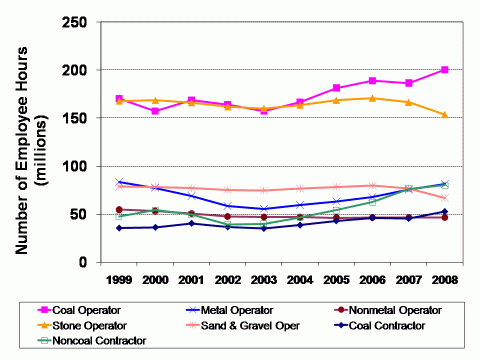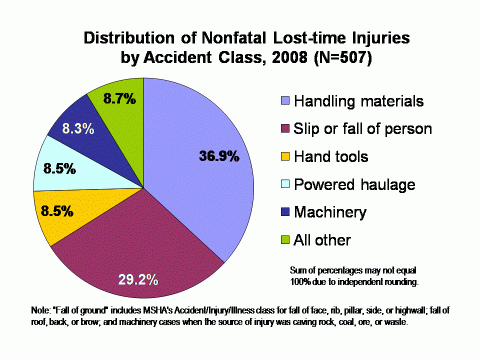Nonmetal Operator Mining Facts - 2008 (HTML)
DHHS (NIOSH) Publication No. 2011–165
Mining Operations
In 2008, a total of 720 nonmetal mining operations reported employment to the Mine Safety and Health Administration (MSHA). [1] Nonmetal mines comprised 4.8% of all mining operations.
- Mines producing clay (including common, ceramic & refractory, fire and not elsewhere classified) comprised 41.0% (n=295) of all nonmetal mining operations.
- Nonmetal mining operations were located in all states and territories except Alaska, Delaware, Hawaii, New Hampshire, Rhode Island, Puerto Rico, and the U.S. Virgin Islands.
Employees
A total of 23,033 employees [2] corresponding to 23,260 full-time equivalent (FTE) [3] employees, were reported to MSHA by nonmetal mine operators.
- Within the mining sectors, [4] nonmetal mine operator employees accounted for 6.8% of all employee hours reported.
- Employee hours were reported at underground (11.7%) and surface (88.3%) work locations. [5]
| Commodity and Type of Employer | 1999 | 2000 | 2001 | 2002 | 2003 | 2004 | 2005 | 2006 | 2007 | 2008 |
|---|---|---|---|---|---|---|---|---|---|---|
| Coal Operator | 170.3 | 157.3 | 168.4 | 163.8 | 157.1 | 166.5 | 181.3 | 189.0 | 186.5 | 200.4 |
| Metal Operator | 83.4 | 77.4 | 68.8 | 58.5 | 55.5 | 59.5 | 63.4 | 67.9 | 75.5 | 81.4 |
| Nonmetal Operator | 54.7 | 53.1 | 50.6 | 47.5 | 46.9 | 46.9 | 46.2 | 46.4 | 46.5 | 46.5 |
| Stone Operator | 167.8 | 168.5 | 166.1 | 161.7 | 160.0 | 163.5 | 168.6 | 170.8 | 166.5 | 153.5 |
| Sand and Gravel Operator | 78.9 | 78.1 | 77.0 | 75.3 | 74.8 | 76.6 | 78.4 | 79.6 | 76.7 | 66.7 |
| Coal Contractor | 35.4 | 36.2 | 40.3 | 36.5 | 35.0 | 38.5 | 43.0 | 46.2 | 45.5 | 52.6 |
| Noncoal Contractor | 47.8 | 54.2 | 49.8 | 39.2 | 39.9 | 46.8 | 54.1 | 62.6 | 76.3 | 80.2 |
Fatalities
There were two occupational fatalities among nonmetal mine operators in 2008.
Nonfatal Lost-time Injuries
There were 507 nonfatal lost-time injuries (95 at underground and 412 at surface work locations) among nonmetal mine operator employees occurring at an overall rate of 2.5 [95% confidence interval (CI): 2.3, 2.8] injuries per 100 FTE employees. A total of 23,708 days lost from work [6] resulted from these injuries.
- The underground nonfatal lost-time injury rate was greater than the surface injury rate (3.5 [CI: 2.8, 4.3] vs. 2.4 [CI: 2.2, 2.6] per 100 FTE workers).
- In 2008, the most frequent classification of nonfatal lost-time injuries involved handling materials (n=187; 36.9%), followed by slip or fall of person (n=148; 29.2%).
- Sprains and strains were the most frequently reported nature of injury (n=230; 45.4%), followed by fracture or chip (n=79; 15.6%).
- The back was the most frequently reported body part injured (n=89; 17.6%) and accounted for 3,057 days lost from work. This is followed by fingers (n=70; 13.8%) and accounted for 2,286 days lost from work.
| Accident Class | Percent |
|---|---|
| Handling materials | 36.9 |
| Slip or fall of person | 29.2 |
| Hand tools | 8.5 |
| Powered haulage | 8.5 |
| Machinery | 8.3 |
| All other | 8.7 |
Mining operations, 2008
| Commodity and Type of Employer | Underground Mining Operations [1] | Surface Mining Operations [1] | Total Mining Operations [1] |
|---|---|---|---|
| Coal | 665 | 1,464 | 2,129 |
| Metal | 105 | 188 | 293 |
| Nonmetal | 44 | 676 | 720 |
| Stone | 111 | 4,522 | 4,633 |
| Sand & Gravel | Not applicable | 7,132 | 7,132 |
| Total | 925 | 13,982 | 14,907 |
Contracting companies, 2008
| Commodity and Type of Employer | Number of Companies |
|---|---|
| Coal | 3,467 |
| Noncoal | 6,128 |
| Total | 9,595 |
Employment characteristics, 2008
| Commodity and Type of Employer | Underground Employees [2] | Surface Employees [2] |
Total Employees | Underground FTE Employees [3] | Surface FTE Employees [3] | Total FTE Employees [3] |
|---|---|---|---|---|---|---|
| Coal Operator | 40,370 | 49,685 | 90,055 | 45,866 | 54,312 | 100,178 |
| Metal Operator | 5,844 | 33,282 | 39,126 | 5,842 | 34,840 | 40,682 |
| Nonmetal Operator | 2,579 | 20,454 | 23,033 | 2,725 | 20,534 | 23,260 |
| Stone Operator | 1,875 | 77,100 | 78,975 | 2,029 | 74,720 | 76,749 |
| Sand & Gravel Operator | Not applicable | 42,307 | 42,307 | Not applicable | 33,343 | 33,343 |
| Operator Total | 50,668 | 222,828 | 273,496 | 56,462 | 217,750 | 274,212 |
| Coal Contractor | 6,262 | 37,510 | 43,772 | 4,105 | 22,216 | 26,321 |
| Noncoal Contractor | 2,992 | 72,459 | 75,451 | 1,998 | 38,088 | 40,086 |
| Contractor Total | 9,254 | 109,969 | 119,223 | 6,103 | 60,304 | 66,407 |
| Total | 59,922 | 332,797 | 392,719 | 62,565 | 278,054 | 340,620 |
Mining Occupational Fatalities (per 100,000 FTE employees), 2008
| Commodity and Type of Employer | Underground Fatalities | Underground Fatality Rate | Surface Fatalities | Surface Fatality Rate | Fatalities | Fatality Rate |
|---|---|---|---|---|---|---|
| Coal Operator | 12 | 26.2 | 6 | 11.9 | 18 | 18.7 |
| Metal Operator | 3 | Not calculated | 2 | Not calculated | 5 | 13.8 |
| Nonmetal Operator | 1 | Not calculated | 1 | Not calculated | 2 | Not calculated |
| Stone Operator | 1 | Not calculated | 6 | 9.4 | 7 | 10.6 |
| Sand & Gravel Operator | Not applicable | Not applicable | 3 | Not calculated | 3 | Not calculated |
| Operator Total | 17 | 30.1 | 18 | 9.4 | 35 | 14.2 |
| Coal Contractor | 3 | Not calculated | 9 | 43.4 | 12 | 48.3 |
| Noncoal Contractor | 0 | Not calculated | 5 | 13.9 | 5 | 13.2 |
| Contractor Total | 3 | Not calculated | 14 | 24.7 | 17 | 27.1 |
| Total | 20 | 32.0 | 32 | 12.9 | 52 | 16.8 |
Nonfatal Lost-time Injuries (per 100 FTE employees), 2008
| Commodity and Type of Employer | Underground Injuries | Underground Injury Rate | Surface Injuries | Surface Injury Rate | Injuries | Injury Rate |
|---|---|---|---|---|---|---|
| Coal Operator | 2,103 | 4.6 | 768 | 1.5 | 2,871 | 3.0 |
| Metal Operator | 163 | 2.8 | 649 | 2.1 | 812 | 2.2 |
| Nonmetal Operator | 95 | 3.5 | 412 | 2.4 | 507 | 2.5 |
| Stone Operator | 33 | 1.6 | 1,593 | 2.5 | 1,626 | 2.5 |
| Sand & Gravel Operator | Not applicable | Not applicable | 550 | 1.9 | 550 | 1.9 |
| Operator Total | 2,394 | 4.2 | 3,972 | 2.1 | 6,366 | 2.6 |
| Coal Contractor | 168 | 4.1 | 313 | 1.5 | 481 | 1.9 |
| Noncoal Contractor | 38 | 1.9 | 463 | 1.3 | 501 | 1.3 |
| Contractor Total | 206 | 3.4 | 776 | 1.4 | 982 | 1.6 |
| Total | 2,600 | 4.2 | 4,748 | 1.9 | 7,348 | 2.4 |
Not calculated when N is less than 5. 95% CI for rates reported above. Totals may not sum due to independent rounding.
Data source: Publicly released employment and accident/injury/illness data collected by MSHA under 30 CFR 50.
Notes: All analyses of accident data exclude office employees. Occupational fatalities exclude all cases under 17 years of age. Further statistical methodology is available on the NIOSH Internet. Caution should be used when interpreting rates based on a small number of events.
- Mines at which only independent contractors were working did not show any employment and were not counted.
- Average number of employees working at individual mines during calendar quarters of active operations (includes office workers).
- Full-time equivalent employees computed using reported employee hours (2,000 hours = 1 FTE).
- Mining sectors includes coal operators, metal operators, nonmetal operators, stone operators, sand and gravel operators, coal contractors, and noncoal contractors.
- Surface work locations include surface operations at underground mines, surface operations (strip or open pit), dredge, other surface operations, independent shops and yards, and mills or preparation plants.
- Includes actual days away from work and/or days of restricted work activity. For permanently disabling injuries only, statutory days charged by MSHA were used if they exceeded the total lost workdays.
To receive NIOSH documents or more information about occupational safety and health topics, contact NIOSH at 1-800-CDC-INFO (1-800-232-4636), TTY: 1-888-232-6348, e-mail: cdcinfo@cdc.gov, or visit the NIOSH Web site.
See Also
- Coal Operator Mining Facts - 2005
- Metal Operator Mining Facts - 2002
- Metal Operator Mining Facts - 2004
- Metal Operator Mining Facts - 2005
- Noncoal Contractor Mining Facts - 2003
- Nonmetal Operator Mining Facts - 2002
- Nonmetal Operator Mining Facts - 2008
- Sand and Gravel Operator Mining Facts - 2006
- Stone Operator Mining Facts - 2003
- Stone Operator Mining Facts - 2005
- Page last reviewed: 3/2/2015
- Page last updated: 3/27/2014
- Content source: National Institute for Occupational Safety and Health, Mining Program


 ShareCompartir
ShareCompartir

